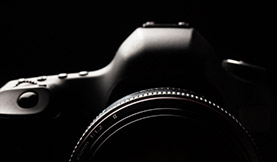When and where to make the cut: inspired by Walter Murch’s In the Blink of an Eye
Check out these Walter Murch inspired editing tips, from his book, In the Blink of an Eye
Editing: The Lovely Mix of Technical Expertise, Artistic License, and Pure Instinct
I thought I would deviate from my usual tutorial format to talk a little more conceptually about the art of editing for today’s post.
I teach a course called Advanced Post Production Workshop at Columbia College Chicago. I created the class as an intensive study in advanced editing and effects techniques—using Avid Media Composer as the platform for instruction.
We begin the semester by cutting a complex dialog sequence, using ScriptSync to help assemble the 40+ camera angles that make up the scene. Because the students have so much to do technically in constructing the scene, they sometimes fail to see the forest for the trees on the first pass. That is, because they have so much material to sort through—and so many decisions to consider—they often tend to get caught up in building the scene, and forget to sit back and really watch.
|
I think a lot of editors run into this issue from time to time. Therefore, it’s nice to introduce elements that really force you to be aware of how the decisions you are making affect your audience. Therefore, with this assignment, I find that it’s beneficial to concurrently study certain techniques from Walter Murch’s In the Blink of an Eye so that they keep constant check on their instincts, and don’t let the technical aspects of editing ruin the story creation process. Specifically, we study three concepts from this text:
|
… |  … … |
The Rule of 6
I love this one, and it’s so important to introduce this to new editors, especially college students—who have had techniques like “Don’t break the 180-degree rule!!” drilled into them from Day 1 of film school.
In the Rule of 6, Murch breaks down the six criteria for a good cut. While his list is somewhat arbitrary in terms of his “percentages,” I think it gets to some excellent points in regard to keeping check on what is important when we made decisions as editors.
Here’s Murch’s list of priorities when analyzing a good cut:
- Emotion: 51%
Is it true to the emotion of the moment? - Story: 23%
Does it advanced the story? - Rhythm: 10%
Does it occur at a moment that is rhythmically interesting and “right”? - Eye-Trace: 7%
Does it acknowledge eye-trace (the concern with the location and movement of the audience’s focus of interest within the frame? - Two-dimensional Plane of Screen: 5%
Does it respect “planarity” (the grammar of three dimensions transposed by photography to two)? - Three-dimensional Space of Action: 4%
Does it respect three-dimensional continuity of the actual space of where people are in the room and in relation to one another?
Now, ideally, every cut will satisfy each of these six criteria. Obviously, however, this is not always an option. So, in short, this list gives priority to the subjective over the objective—that is, it challenges the editor to weigh things like emotion and story significantly more than 2D and 3D spacial considerations. Murch even assigns emotion a value of 51%, which means that cutting based on emotion is more important than the other five criteria combined.
This sort of check-in is so important, especially in an exercise where my students are considering almost four dozen camera angles to compose a dialog scene. It can be easy to give up trying to find the perfect emotional delivery in favor of finding a shot that just “fits.” But that’s the beautiful thing about an editing class—everyone is given the same exact footage, but ends up with drastically different results. Indeed, when it comes time for peer critiques and in-class screenings, it’s blatantly clear that the students who honored emotion, story, and rhythm first and foremost resulted in the most compelling scenes. It only takes one screening before the rest of the students “get it,” and begin to assess their cutting decisions in a whole new way.
Don’t Worry, It’s Only a Movie
Murch’s theory of assigning the human blink as emotional punctuation is one of the most interesting things I’ve heard about editing. Besides reading his book, of course, I recommend that you listen to him talk about it on this episode of Radiolab (my favorite podcast).
Basically, though, here’s what it boils down to:
Murch was cutting the 1974 film, The Conversation, when he discovered something very strange. He found that every single time he decided to make a cut, Gene Hackman’s character, Harry Caul, would blink very close to the point where he decided to cut. He continued to explore this notion, and came to the conclusion that often, a person will blink every time he or she has a new whole thought or emotion.
“So it seems to me,” Murch says, “that our rate of blinking is somehow geared more to our emotional state and to the nature and frequency of our thoughts than to the atmospheric environment we happen to find ourselves in. The blink is either something that helps an internal separation of thought to take place, or it is an involuntary reflex accompanying the mental separation that is taking place anyway.”
The trick with incorporating this technique into my class is that I try getting them to read this chapter after they’ve done their rough cut, but before they’ve done the fine cut. Then, they can assess whether or not Murch’s theory holds true. I ask them to count how many times their characters blink on or around their chosen cut, and then, in the fine cut, they refine the edit with this knowledge up their sleeve. Often, they’ll find that there really is something to it!
Dragnet
This is another great one—especially, again, for film students. Every new editor starts out cutting semi-Dragnet style, in which both the video and audio of each character’s entire line is included within each edit. Therefore, it tends to play a bit like a tennis match, like so: (from In the Blink of an Eye)
Have you seen your son? (cut)
No, he didn’t come home last night. (cut)
What time does he usually come home? (cut)
Two o’clock. (cut)
This style of cutting, which is named Dragnet for its “hard-boiled, police blotter realism,” made famous by the TV series of the same name, results in the students’ Timeline dissected a hundred times with straight cuts, and nothing more. Again, this is very common in beginning editors.
Says Murch: “The ‘Dragnet’ system is a simple way to edit, but it is a shallow simplicity that doesn’t reflect the grammar of complex exchanges that go on all the time in even the most ordinary conversations. If you’re observing a dialogue between two people, you will not focus your attention solely on the person who is speaking. Instead, while that person is still talking, you will turn to look at the listener to find out what he thinks of what is being said. The question is: When exactly do you turn?”
And that’s where the bit about the blink comes in very handy. Indeed, this is how I implore them to use something so very simple—the L cut—and ask them to truly consider where we, as the viewer, want, or even need, to see a reaction shot, a lingering shot, or a cutaway. It is certainly fun to watch the students begin with all straight cuts, and then go back and re-edit the scene until there are almost no straight cuts, because they are learning to anticipate what the audience wants/needs to see.
Your job is partly to anticipate, partly to control the thought processes of the audience,” says Murch. “To give them what they want and/or what they need just before they have to “ask for it—to be surprising yet self-evident at the same time.”
When students get that, it’s a very fun thing to watch.





